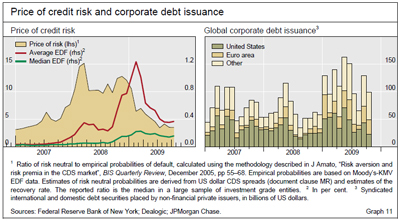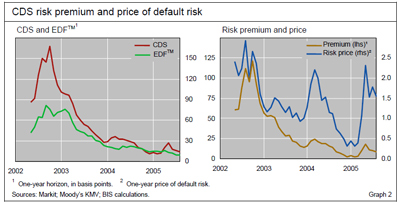The Investment Industry Regulatory Organization of Canada is going after Deutsche Bank for not functioning as Coventree’s Investor Relations department in the ABCP affair. Assiduous readers will recall that domestic banks are expected to enter a golden age:
But Mr. Downe said the exit of a number of non-bank competitors in the lending market means that the banks should be able to earn more on their loans.
“I think that the prospects for good asset growth at better margins over the next couple of years are quite realistic,” he told analysts on a conference call, adding that the banking system is absorbing more than $1-trillion worth of short-term financing previously done by other lenders.
PrefBlog anticipates that this golden age will bring with it the necessity of hiring many experienced compliance personnel at fat salaries. The whole thing is laughable: it is impossible to determine whether domestic banks’ BAs are junior, senior or pari passu with BDNs, but this lack of disclosure doesn’t worry their future staff members in the least.
It should be clear, however, that Alistair Darling will not be looking for work in finance:
Chancellor of the Exchequer Alistair Darling imposed a 50 percent levy on banker bonuses and said he will increase income taxes after elections next year as the worst recession on record drives up U.K. government borrowing.
But then, perhaps he likes living in London.
DBRS has placed Dexia preferreds and sub-debt on review negative following their October 30 announcement that, in order to get state aid, they had to agree that they would (among other things):
not to make any payment of any discretionary coupons, or to exercise any call options on any hybrid Tier 1 instruments or on any Upper Tier 2 perpetual instruments issued by any entity of the Group. Within this context, Dexia undertakes in particular (a) not to pay the coupons relating to the Tier 1 issues of Dexia Funding Luxembourg S.A. (November 2, 2009) and Dexia Crédit Local (November 18, 2009), and (b) to waive exercise of the call option on the Upper Tier 2 issue of Dexia Bank Belgium (Isin BE0116241358) dated November 18, 2009. The Dexia Group will issue a further communication in relation to the payment of the coupons for the Upper Tier 2 issue of Dexia Bank Belgium (Isin BE0116241358);
Volume jumped considerably today although price action was muted, with PerpetualDiscounts gaining 6bp and FixedResets up 1bp.
PerpetualDiscounts now yield 5.88%, equivalent to 8.23% interest at the standard equivalency factor of 1.4x. Long Corporates now yield just a hair under 6.0%, so the pre-tax interest-equivalent spread (also referred to as the Seniority spread) is now about 225bp, a slight tightening from the 230-235bp level reported on December 2.
| HIMIPref™ Preferred Indices These values reflect the December 2008 revision of the HIMIPref™ Indices Values are provisional and are finalized monthly |
|||||||
| Index | Mean Current Yield (at bid) |
Median YTW |
Median Average Trading Value |
Median Mod Dur (YTW) |
Issues | Day’s Perf. | Index Value |
| Ratchet | 0.00 % | 0.00 % | 0 | 0.00 | 0 | 0.1955 % | 1,522.2 |
| FixedFloater | 6.03 % | 4.15 % | 36,743 | 18.59 | 1 | 0.1111 % | 2,581.6 |
| Floater | 2.56 % | 3.03 % | 99,930 | 19.57 | 3 | 0.1955 % | 1,901.7 |
| OpRet | 4.85 % | -3.53 % | 148,024 | 0.08 | 15 | 0.0944 % | 2,311.7 |
| SplitShare | 6.41 % | -2.82 % | 259,699 | 0.08 | 2 | 0.1328 % | 2,096.3 |
| Interest-Bearing | 0.00 % | 0.00 % | 0 | 0.00 | 0 | 0.0944 % | 2,113.9 |
| Perpetual-Premium | 5.86 % | 5.64 % | 66,277 | 2.36 | 7 | 0.3642 % | 1,881.9 |
| Perpetual-Discount | 5.82 % | 5.88 % | 199,359 | 14.04 | 68 | 0.0571 % | 1,787.3 |
| FixedReset | 5.42 % | 3.75 % | 366,932 | 3.89 | 41 | 0.0134 % | 2,155.7 |
| Performance Highlights | |||
| Issue | Index | Change | Notes |
| ELF.PR.G | Perpetual-Discount | -1.93 % | YTW SCENARIO Maturity Type : Limit Maturity Maturity Date : 2039-12-09 Maturity Price : 17.76 Evaluated at bid price : 17.76 Bid-YTW : 6.82 % |
| CIU.PR.B | FixedReset | -1.53 % | YTW SCENARIO Maturity Type : Call Maturity Date : 2014-07-01 Maturity Price : 25.00 Evaluated at bid price : 28.31 Bid-YTW : 3.62 % |
| IAG.PR.A | Perpetual-Discount | -1.45 % | YTW SCENARIO Maturity Type : Limit Maturity Maturity Date : 2039-12-09 Maturity Price : 18.97 Evaluated at bid price : 18.97 Bid-YTW : 6.08 % |
| CM.PR.K | FixedReset | -1.15 % | YTW SCENARIO Maturity Type : Call Maturity Date : 2014-08-30 Maturity Price : 25.00 Evaluated at bid price : 26.65 Bid-YTW : 3.93 % |
| PWF.PR.H | Perpetual-Discount | -1.02 % | YTW SCENARIO Maturity Type : Limit Maturity Maturity Date : 2039-12-09 Maturity Price : 23.83 Evaluated at bid price : 24.20 Bid-YTW : 6.01 % |
| CM.PR.D | Perpetual-Discount | 1.01 % | YTW SCENARIO Maturity Type : Limit Maturity Maturity Date : 2039-12-09 Maturity Price : 24.79 Evaluated at bid price : 25.10 Bid-YTW : 5.79 % |
| BMO.PR.H | Perpetual-Discount | 1.02 % | YTW SCENARIO Maturity Type : Limit Maturity Maturity Date : 2039-12-09 Maturity Price : 22.79 Evaluated at bid price : 23.71 Bid-YTW : 5.59 % |
| GWO.PR.F | Perpetual-Premium | 1.23 % | YTW SCENARIO Maturity Type : Limit Maturity Maturity Date : 2039-12-09 Maturity Price : 24.29 Evaluated at bid price : 24.60 Bid-YTW : 6.00 % |
| Volume Highlights | |||
| Issue | Index | Shares Traded |
Notes |
| GWO.PR.H | Perpetual-Discount | 66,377 | Nesbitt crossed 60,000 at 20.11. YTW SCENARIO Maturity Type : Limit Maturity Maturity Date : 2039-12-09 Maturity Price : 20.10 Evaluated at bid price : 20.10 Bid-YTW : 6.05 % |
| GWO.PR.G | Perpetual-Discount | 65,426 | RBC crossed 54,600 at 21.56. YTW SCENARIO Maturity Type : Limit Maturity Maturity Date : 2039-12-09 Maturity Price : 21.48 Evaluated at bid price : 21.48 Bid-YTW : 6.07 % |
| MFC.PR.D | FixedReset | 62,713 | Nesbitt crossed 45,000 at 27.81. YTW SCENARIO Maturity Type : Call Maturity Date : 2014-07-19 Maturity Price : 25.00 Evaluated at bid price : 27.81 Bid-YTW : 3.92 % |
| SLF.PR.B | Perpetual-Discount | 60,100 | TD crossed 19,500 at 20.10; RBC crossed 25,000 at the same price. YTW SCENARIO Maturity Type : Limit Maturity Maturity Date : 2039-12-09 Maturity Price : 20.10 Evaluated at bid price : 20.10 Bid-YTW : 5.99 % |
| RY.PR.R | FixedReset | 57,700 | RBC crossed 45,000 at 27.75. YTW SCENARIO Maturity Type : Call Maturity Date : 2014-03-26 Maturity Price : 25.00 Evaluated at bid price : 27.73 Bid-YTW : 3.61 % |
| PWF.PR.D | OpRet | 56,960 | RBC crossed 50,000 at 26.50. YTW SCENARIO Maturity Type : Call Maturity Date : 2010-01-08 Maturity Price : 25.60 Evaluated at bid price : 26.39 Bid-YTW : -23.84 % |
| There were 49 other index-included issues trading in excess of 10,000 shares. | |||

